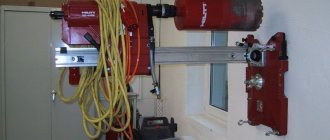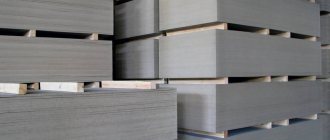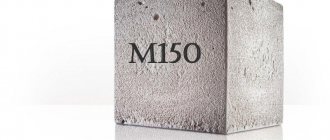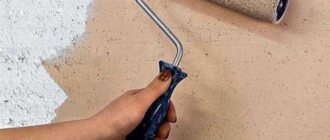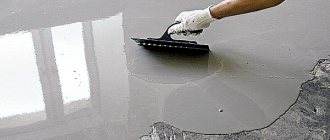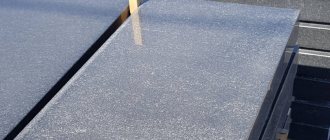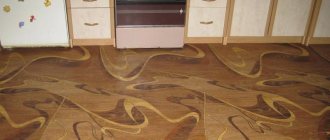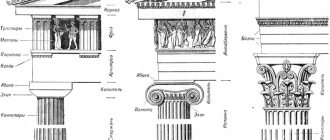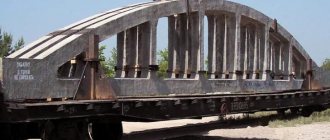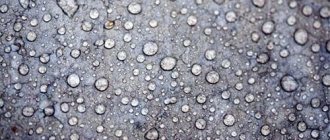Solid wood or chipboard? Pros and cons of materials
Solid wood, chipboard, MDF, fiberboard - what do these terms mean, and how can an unenlightened buyer not get confused by them? What is the furniture around us made of - wardrobes, chests of drawers, cabinets, furniture for the kitchen, bathroom and bedroom?
Solid wood
Furniture made of solid wood gives solidity and a noble appearance to the room. Often, this is exclusive furniture made to order.
+
naturalness and environmental friendliness of the material;
—
natural wood is prone to darkening and is sensitive to dampness and temperature changes;
—
expensive and not always available option.
A cheaper analogue is furniture made from wood boards. MDF, chipboard, laminated chipboard, fiberboard are materials based on wood, but in the form of shavings, fibers and sawdust. Most often this is wood processing waste, as well as raw materials obtained during sanitary cutting of trees.
The classic option for furniture production is: the front part is made of MDF, the body is made of laminated chipboard, the back wall is made of fiberboard.
Medium Density Fiberboard
(from the English. Medium Density Fiberboard - MDF -
MDF
). In the production of MDF, the raw materials are ground practically into dust and mixed with organic or non-toxic resins. It is a material that is easy to process, which is very valuable in the manufacture of furniture that requires grace and fine lines.
+
the density of the board, which almost matches the density of natural wood, holds screws and other fasteners well;
+
ability to produce bent furniture elements
+
The stove is immune to microorganisms, mold and fungi.
—
reacts painfully to temperatures above 70 degrees Celsius: it swells, warps, and the decorative coating bubbles and peels off, which is why MDF furniture is not recommended to be placed near heating devices;
—
furniture made entirely from MDF is quite expensive, so such boards are most often used only in the production of facades.
Chipboard and laminated chipboard
Chipboard
(the official abbreviation is
DSTP
, colloquially chipboard) is made by hot pressing large chips mixed with a binder - synthetic resin. Chipboard was produced back in the 1930s by the German inventor Max Himmelheber, and in 1951 he received a patent for his invention. “Ideal wood” - that’s what chipboard was called back then for its homogeneous structure and the absence of defects inherent in wood (knots and cracks).
The most common material for the production of cabinet furniture is laminated chipboard.
- or
LDStP
, colloquially LDSP. This is chipboard, onto which decor is glued on both sides, imitating the texture of various types of wood.
+
products made from laminated chipboard are resistant to moisture due to the laminating coating, in contrast to the solid wood counterpart described above. Furniture products made from laminated chipboard are as convenient as possible during operation: they can be easily cleaned and washed with usual detergents. Although, of course, it is better to avoid abrasive preparations, they can ruin the surface;
+
low price with a large number of color solutions;
—
the material is not suitable for creating bent furniture elements;
—
The main negative characteristic of particle boards is the presence of formaldehyde resins, which, in high concentrations, have a negative effect on human health. That is why it is necessary to ensure that the finished product contains as few uncoated areas of chipboard as possible.
Since 1986, an international scale has been in force that determines the emission class of wood-tile materials. It regulates the content of free formaldehyde in the products of manufacturing companies. The following international classification has been adopted: formaldehyde-free board of emission class E0.5 is used in the production of special furniture, for example, medical and children's furniture. Furniture made from chipboard with emission class E1 is approved by all Western countries, Ukraine and Russia for use in residential premises
. Chipboard with emission class E2 is prohibited for use in residential premises by the ministries of health of all European countries. EZ - wood boards suitable only for use in construction.
Fiberboard and fiberboard
Fiberboard
or
fiberboard,
in common parlance - hardboard. The composition is similar to MDF, but is less dense and thick, and does not have a decorative finish. The use of such a board in the production of furniture makes the product more affordable.
Treated fiberboard
or
DVPO.
A slab, one side of which is painted in a single color or imitates wood. The scope of application of such a plate in the manufacture of furniture is limited: the back walls of cabinets, the bottoms of drawers and other parts that do not involve a large load.
Comparison with other materials
Compared to MDF, particle boards have higher strength, but low environmental friendliness. In the production of MDF, only natural, environmentally friendly resins are used. MDF is made by dry pressing of ground sawdust with the addition of natural resins. MDF is not as widely used as chipboard, but is more expensive. The area of use of this material is the production of kitchen facades, doors, interior partitions, and trims. It lends itself well to milling, gluing, painting and laminating.
Wood-fiber boards (Fibreboard) are made by wet pressing of wood dust. Thanks to low-cost technology, fiberboard has a low cost. But unlike chipboard and MDF, the material is used in a narrow area. The back walls of furniture, the bottoms of table drawers and other fragile auxiliary elements are made from fiberboard.
Plywood is the leader in strength among wood boards. It is made by gluing layers of veneer with different grain directions. This provides it with maximum strength and resistance to stress. The disadvantage of plywood is its high cost. If you choose a material for flooring, you can get by with cheaper chipboard, but for the manufacture of room partitions or similar structures, plywood is best suited. In addition, plywood is the leader in environmental friendliness among the entire list of wood-based panels.
Advantages and disadvantages
Advantages of the material:
- Easy to install. Chipboards are easy to process and can be cut with a hand saw or an electric jigsaw. Installation is carried out on a leveled base or frame. But when working with decorative variations, trimming may require special equipment to achieve clean edges.
- Acceptable strength. This indicator is determined by the density: the higher it is, the stiffer the product. The resulting cladding withstands mechanical loads well.
- Decorative. Existing options significantly expand the scope of use of the material and allow you to create an attractive appearance.
- Low thermal conductivity. This indicator is determined from the density of the parts; the coefficient varies from 0.11 to 0.23 W/(m °C) under normal operating conditions.
- Price. The price of the product depends on its characteristics, but remains quite affordable.
Despite the fairly wide gradation of particle boards: according to purpose, density and other parameters, the price of the material remains affordable.
Disadvantages of chipboard:
- Various environmental parameters. The sheet contains formaldehyde resins. Their number is strictly limited, but for finishing work it is better to use options completely covered with decorative film.
- The need for proper fastening. The structure of the material does not have integrity, so the fixation points should not be located close to the edge. To avoid damage to the front part (especially when working with decorative varieties), preliminary drilling is carried out.
- Impossibility of complex finishing. Curly cutting can only be done using special equipment. The surface is not amenable to large-scale milling.
- Low water resistance. This disadvantage applies to standard products that are not used in wet areas. If it is necessary to perform decorative work, the edges must be closed.
With prolonged exposure to moisture on chipboard, the material loses strength, swells and begins to crumble, and it is no longer possible to restore the board
When purchasing material, you need to check for certificates of conformity.
Stages and features of production
To make chipboard, raw materials of different sizes and types are used:
- chips: they are produced on rotary-type machines;
- chips are the result of the operation of special equipment (for example, a chipper or a knife shaft).
To produce particle boards, you need raw materials whose particles correspond to standard parameters with deviations (to a lesser extent from the specified values):
- thickness – 0.5 mm;
- width – 5 mm;
- length – 40 mm.
The quality of the finishing material depends more on the thickness of the chips. It is better if it is as thin as possible. When specially harvested wood is used, rather than production waste, round timber or large boards will be needed. After preparation (removing the bark, dividing into smaller pieces, soaking), the material is crushed. This is how the raw materials are obtained, which are used to produce the top layer of the slab. Inside there are large chips, they are compressed, but in the section you can see the difference between the structure of the layers. To improve the quality of the raw material, it is additionally dried and sifted, then re-grinded.
Stages of plate production:
- All types of raw materials (for internal and external layers) require drying. This is done after calibrating it in size.
- The chips fall into the mixers, which are constantly rotating. Here it is mixed with binding components. It is important that every particle is coated with resin. This result is achieved by blowing a stream of air along with drops of the binder component. The resin envelops the chips.
- The mass falls on the conveyor belt, where future sheets are formed - layers of material of different thicknesses are created.
- The layer is cut into slabs and compacted using the vibrocompression method at a temperature of +180°...+220°C.
- Heating can increase the strength of the boards, which is achieved due to the effect of temperatures on the resin.
- Products are cooled. Moreover, to obtain materials with the desired properties, a gradual decrease in the temperature of the plates is required - in a natural way.
Chipboard varieties
There are chipboard slabs of 1st grade, 2nd grade, as well as non-grade slabs, used, as a rule, for construction purposes. The main differences between grades 1 and 2:
No protrusions or depressions, resin or paraffin stains are allowed on the first grade chipboard board;
On a first-grade chipboard slab, chipping of edges and chipping of corners is not allowed (with the exception of single chips (chipping) up to 3 mm and extending along the edge up to 15 mm); on a second-grade chipboard slab, chipping of the edges is allowed within the limits of deviations along the length (width) of the slab;
there may be grinding defects on the surface of the second grade chipboard slab (no more than 10% of the area);
On the surface of a chipboard slab of the second grade, inclusions of bark and large fractions of chips may be present to a greater extent compared to the first grade.
We advise you to study - Types of siding for cladding a house
Scope of application of chipboard
Wood panels can be used both in the production of furniture and in the following cases:
- for the construction of parts of building structures;
- when creating enclosing barriers at construction sites;
- as a mold for casting concrete during repair and construction work;
- for creating structures on various sports grounds;
- as a subfloor substrate if several layers are planned;
- in the production of interior doors;
- used as flooring materials;
- used as wall and ceiling slabs;
- for covering wagons and other containers for storage and transportation;
- for the construction of exhibition racks and stands for advertising purposes;
- slabs are used as cladding for roof coverings.
In furniture production, this material is valued for its flexibility to change and bend, the different colors imaginable, ease and speed of assembly, and universal availability.
Notes[edit | edit code]
- ↑ V. E. Kuznetsov Furniture Maker's Directory. Designs and functional dimensions. Materials. Production technology. - M.: Timber Industry, 1985.
- ↑ A. A. Bartashevich. Furniture design. - Mn.: Modern School, 2006. - ISBN 985-6751-31-4.
- ↑ Both abbreviations are used to designate these plates - chipboard (incorrectly) and DSTP (officially). The first option is much more common, although in regulatory documents chipboard is used (since chipboard by that time was already used to designate wood-laminated plastics).
- ↑ GOST 27935-88 “Fibreboards and particle boards. Terms and Definitions".
- ↑ Ofitserova L.I. Structures made of wood and plastics: a course of lectures for students of construction specialties. Part 2. - Tomsk: STT, 2006. - P. 94.
- ↑ 12
John I. Zerbem, Zhiyong Cai, George B. Harpole. An Evolutionary History of Oriented Strandboard (OSB) // United States Department of Agriculture, 2015. - ↑ 12
GOST 10632-2014 “Wood-based particle boards. Technical specifications" - ↑ Both within one slab and within a batch of slabs
- ↑ V. Strelkov, V. Bardonov. Accurate to one hundredth?. // Furniture business No. 1, 2013
- ↑ Extruded chipboards - light and elegant // LesPromInform No. 6 (55), 2008.
- ↑ GOST 32289-2013 “Particle boards lined with films based on thermosetting polymers. Technical specifications"
- ↑ Extrusion chipboards: full face and profile // “LesPromInform” No. 9 (58), 2008.
Chipboard production
The technology for producing wood boards consists of mixing wood raw materials with an adhesive agent and pressing under high pressure and temperature. The production cycle helps turn substandard viscous mixture into a finished product.
Equipment
The technological cycle of chipboard manufacturing is based on the use of simple and high-performance equipment, which is a single complex. The use of high technology on production lines is not mandatory, although setting up and maintaining the continuous production state of all machines on the line is a difficult task that cannot be solved in a standard way.
The chipboard production line includes:
- mixers - necessary to achieve uniformity of raw materials when mixing sawdust and a binder (a resin composite with a thermohardener, to which special substances can be added that give special characteristics to the slabs);
- devices for shaping - they form a viscous mixture of wood raw materials with a binder in portions for the production of boards;
- devices for pressing at high temperatures - necessary to ensure that the formed chipboard blank hardens under high pressure and temperature;
- cooling devices – responsible for accelerating the cooling of compressed sheets;
- devices for cutting edges - for removing the ends of slabs;
- grinding machines – give smoothness to the formed top layer of slabs.
In this case, the devices operate automatically, and quality management and support of system settings at a given technological level occur simultaneously.
Manufacturing technology
The chipboard production technology is a rather labor-intensive process, but with proper automation it does not require much attention and control from people.
First, the raw materials are processed. It includes such stages as: receiving or unloading chips; sorting chips by size; and purification from impurities. As part of the first stage, the wood is analyzed for its fraction: if it is small, then it is transferred further; otherwise it is crushed, after which it moves on. The second stage is sorting the chips by size. This is where the separators are divided into small and large parts and placed in different containers. For the surface layer, small shavings and sawdust are used, as well as grinding dust. Moreover, the inner layer contains these components up to 20% of the total mass. After purification from impurities, the resulting mixture moves to the second stage.
The second stage of the cycle is drying the resulting mixture. In this case, chips of different layers are dried separately in order to comply with humidity standards. Thus, the moisture content of the final mixture for the inner layer should be in the range of 2-4%, and for the remaining layers - 4-6%. In the production of slabs, convection drying is usually used.
After the chips have dried, stage 3 begins, during which the chips are coated with a binder or mixture. It is important that each individual chip is coated with the mixture to better bind into a single layer. In this case, it is also necessary to calculate the correct % of binder to avoid overuse. Both of these characteristics affect the quality of the final slab.
Forming the resulting viscous mass into a wood board shape. Molding devices are responsible for this, which precisely divide the carpet of the viscous mixture into portions, from which chipboard sheets will then be made. The main thing here is that the mixture is distributed evenly both in length and thickness, otherwise the quality of the slab will be lower.
Next, the portion follows to the press. There it is compressed at a pressure of 30-40 kg/cm2 and a temperature of 180–220 °C. At the same time, 2 types of units are common: extrusion and flat. As a result of pressing, an almost finished sheet of chipboard is obtained, but still hot.
The resulting chipboard board must be cooled for two reasons. The first is the high temperature after leaving the heat-pressing unit, the second is the difference in temperature and humidity between the layers, which is quite significant. Thus, the difference in humidity can reach up to 7-10%, which can cause internal stress, which, during subsequent hot processing of the board, can lead to deformation of the chipboard.
Therefore, what follows next is the cooling and cutting stage, during which the chipboard sheet is cooled to a temperature at which it is convenient to transform it further. Often, fan-type devices are used for cooling.
After the slab has cooled, it passes through the line first to the edge trimming device, and then to the grinding machine. The edge trimming device will bring the chipboard board to predetermined dimensions, and the grinding device will make the board surfaces smooth.
This completes the production process. Next, the chipboard slabs are either sent to be covered with protective films (laminate, veneer, and others), or are delivered to a warehouse and sent to consumers in this form. Before packaging, chipboards are sorted by grade.
Certificate of conformity
Within the industry, there are 3 areas of certification of products manufactured by chipboard production, carried out in three areas:
- compliance with the requirements of generally accepted standards (CIS Standard, GOST);
- fire safety compliance;
- compliance with environmental and sanitary requirements.
GOST 10632-2014 Particle boards. Specifications
1 file 198.92 KB
Technical characteristics of chipboard
This material is produced in sizes that comply with GOST 10632-2007.
- The length of products can vary from 1830 mm to 5680 mm.
- Width – from 1220 to 2500 mm.
- Thickness from 3 mm.
There are 2 main grades of material.
P-A.
High-quality material that can withstand bending and tensile loads and exposure to moisture. It is this material that chipboard is faced with.
P-B.
This brand has lower characteristics and is not subjected to cladding.
The main technical characteristics of chipboard are density, water absorption, hygroscopicity. Today it has been proven that density is not the main indicator affecting the strength of a material. Much more important is its ability to hold fasteners. And this property is directly related to the quality of the surface. If it is smooth, without flaws, and strong, then the entire slab will cope well with the loads.
The density of the material depends on the thickness of the slab:
- 8 mm – 740 kg/m³;
- 10 mm – 720 kg/m³;
- 20 mm – 670 kg/m³;
- 30 mm – 620 kg/m³;
- 38 mm – 600 kg/m³.
Water absorption depends on the type of slab, its density, and the number of binding components. If urea-formaldehyde resins are added, then the product will absorb from 30 to 90% of moisture per day. This will reduce the strength of the products by 3 times. If the composition contains hydrophobic components, then the technical characteristics of the chipboard associated with the ability to contact with water will increase significantly.
Hygroscopicity is another characteristic that shows how a material absorbs moisture from the air. The equilibrium moisture content of chipboard is lower than that of plain wood. This means that when placed in a room with high humidity, the material will have a higher equilibrium humidity than under normal conditions.
Overview of types of chipboard
In its original form, chipboard is used without additives, auxiliary layers, or structural elements. However, it is often necessary to use improved material. This led to the emergence of different types of slabs:
- laminated (laminated chipboard): coatings of several varieties are tried on (paper-resin film, plastic and paper-laminated material), which can affect the properties of the product;
laminated chipboard
- fire-resistant boards: contain fire retardants, making the material more resistant to high temperatures;
- moisture-resistant: they contain urea-melamine resins, hydrophobic polymer additives; boards of this type can be distinguished by their greenish tint;
Moisture-resistant chipboard
- veneered: similar to solid wood, but only externally, because the outside is covered with veneer, due to which the material imitates natural wood;
- tongue-and-groove (chipboard Quick Deck): they differ in the configuration of the cuts; grooves and tenons are formed here, making it possible to assemble a seamless durable coating.
Tongue-and-groove chipboards.
Separately, perforated boards should be noted. They are produced by extrusion. This type of material is used primarily in the production of door panels (laid inside), so it is not found on the open market. Features of such plates:
- presence of through holes;
- high sound insulation qualities;
- increased thermal insulation;
- resistance to deformation due to exposure to temperature changes.
The narrow scope of application of such chipboard is also due to its insufficiently high strength. Veneered material differs from this variety. For the coating, veneers of different species are used, but more often - oak, ash, which improves the quality of the slab, it becomes stronger, and better resists mechanical loads. Veneer, like lamination, gives the material decorative qualities. At the same time, wear resistance increases. At the same time, moisture resistance increases.
Important! Even if the material is covered with veneer or polymer film, this does not make it waterproof. Such slabs withstand exposure to a humid environment better. However, prolonged contact with water is not recommended. The material remains hygroscopic, depending on the type, it swells by 5-30%, which means it is deformed in such an environment.
MDF kitchens ↑
The ability to bend the panel transforms utilitarian standard kitchens into spaces that are not devoid of personality and are more suitable for their owners
This is especially important when the kitchen is small: there is no opportunity to play with the arrangement of furniture or the introduction of original details - only the form remains, and MDF ensures its variability
These curved facades are not the work of software at all. The doors are made of perforated MDF - a kitchen that is ordinary in all respects with a standard arrangement of furniture looks extraordinary thanks to the rounded cabinets. And this is the simplest option of all possible.
What in this kitchen in the photo is made of wood? It's likely nothing. Even a log may turn out to be plastic (or polystone, which perfectly imitates any natural materials). The floor, ceiling and furniture fronts (we remind you: the material can be milled) are made of MDF.
Here's some great country music. Either natural wood or MDF can hold glass (especially stained glass) - laminated chipboard will crumble a little faster than instantly. When working with MDF, the master is spared from endless trials in search of the only desired shade (the paintwork, when placed on natural wood, changes color in accordance with the tone and texture of the base), and the customer is spared from exorbitant expenses.
White carved facades - you can make them from solid wood, painting them and thereby destroying the texture of the wood, or you can avoid blasphemy by giving preference to MDF.
We don’t dare judge how good the floral patterns on furniture facades are (a matter of taste), but it’s almost impossible to depict something similar on laminated chipboard: it will look dingy, since laminated chipboard is processed at the production stage, and MDF is processed after, additionally, which expands the capabilities of designers to almost limitless.
You can make almost any kitchen out of MDF (almost - because there is also stainless steel) - realize a bold idea, create something truly original and enjoy the result every day. Only an array can be better (and even then not always). In our opinion, only an acute lack of funds and an equally urgent need for furniture can drive us into the framework of chipboard. But this solution will be temporary (the furniture will quickly peel off). Make the right choices.
Classification[edit | edit code]
- Construction: based on the number of layers, chipboard is divided into single-layer, three-layer and multi-layer.
- Brand: depending on the bending strength, deformation, water resistance, susceptibility to warping and deformation, chipboard is divided into 2 grades: P2 and P1.
- Grade: depending on the criteria for the appearance of the slab (cracks, chips, staining, stains, protrusions and depressions), chipboard slabs are divided into 1st grade (defects other than minimal ones are not acceptable), 2nd grade (large surface defects are acceptable) and without grades (cardinal surface defects, used in construction).
- Outer layer: slabs with a fine-grained surface (possible lining with polymer materials), regular (veneered veneer is used) and coarse-grained (used in construction) are distinguished.
- Level of surface treatment: sanded and unsanded chipboard are distinguished.
- Formaldehyde emission class: according to the content of free formaldehyde in 100 g of dry chipboard, classes E1 (less than 10 mg), E2 (from 10 to 30 mg) are distinguished.
- Water resistance: in addition to the fact that the P2 brand board has better water-resistant properties (22% deformation versus 33% for P1 when immersed in water for a day), there is a separate type of waterproof chipboard intended for the production of furniture and specific construction work.
- Fire resistance: when fire retardants are added to the chipboard composition, the board acquires fire-resistant characteristics. Now [ when?
] production of this type of chipboard is not carried out on the territory of the Russian Federation. - Density: according to density, chipboard is divided into low-density board (less than 550 kg/m³), medium (550-750 kg/m³) and high-density (more than 750 kg/m³).
- By pressing method: flat or extrusion pressing.
Production technology and classification of chipboard
Laminated chipboard facing boards differ in composition, quality and are divided into several types:
- rough - they do not have a decorated coating;
- laminated covered with finishing and sulfite paper;
- veneered ones are coated with natural wood veneer.
The quality of the slabs can be of three grades depending on the characteristics:
- Grade 1 is made only from selected sawdust and almost always from the same tree species. When finished, it has a perfectly smooth surface. It is laminated on both sides with a special film or veneer.
- Grade 2 is distinguished by minor damage to the surface in the form of chips or scratches. Such slabs can be produced with or without coating.
- Grade 3 is characterized by significant defects, so they are not covered by anything and are widely used in this form for construction and auxiliary purposes.
The material has a certain degree of resistance to external factors:
- moisture-resistant - so that such a sheet is not afraid of moisture, it undergoes a special treatment with paraffin emulsion, and it contains wood fibers with special impregnation, which prevents the slabs from swelling from exposure to moisture.
- fireproof - fire retardants are added to the composition, they create a barrier to fire.
Before getting into hardware stores and furniture factories, laminated chipboard sheets go through several mandatory stages in the production process.
- Stage 1 - obtaining production, which uses wood chips as the main component. Raw materials are placed in special mills, where they are crushed to the required state.
- Stage 2 - drying and collection. Now the chips enter the dryer and pass through vortex flows of hot air. The humidity of the incoming raw materials immediately after processing is reduced by 6-7%. When dried, the chips enter a cyclic installation, where they are sorted, and those that are too large are returned again for grinding.
- Stage 3 - mixing the components. The selected chips enter the mixer chamber and formaldehyde resin is added to them.
- Stage 4 - creating forms. The mixed composition of raw materials is supplied to a conveyor belt, where it is cold pressed, after which a shape is created from several layers. Chipboard sheets are produced under the influence of a hot press. The material is cooled and dried, after which they are sawn into sheets of standard sizes.
- Stage 5 - application of decorative coating. The surface of the sheets is leveled and polished and then they enter the forming press. The sheets are covered with finishing and sulfite paper.
VALUE AND SYNOPSIS OF THE SYSTEM
This is the case with the world of the world, and the world of the world. This is what you need to know. The basic idea is that this is the case.
Proceedings from this region. The basics of the world - the system and the world Well, that's all. This is the case with the Russian Federation, the Russian Federation, the Russian Federation, and the Russian Federation. more information about the world. DAS 2 sides, roundabouts: Ï-À and Ï-à. DANIEL SYLLABUS AND ESSENTIAL SYSTEMS about the region. ALL OTHER POSITIONS OF FOLLOWING P.-A. the other side and the other side of the world. About the world in the world. this is the case with DASH in the context of the situation. But with this, with the same name, with the same name That's it. This is the 3rd line. 3 sîòî – vâûáðàîàêàêàè èîîæåò ïðèìåíÿòüñîòîúêîîîîêîêîêîâîâñââñââìâ this is the case in the region. This is the main point of view of this matter. About the new state of affairs in Russia and in other words. The current world is a modern world, in other words MASSIVE VALUES. This is the same as the other one. That's the case, that's how it works.
We advise you to study - Laminate or parquet boards, which is better - comparison of characteristics
LAMINATIONAL SYSTEMS. This is also the case with the 1st line. But this is the meaning of the word. This is the diasporic world in the world this is the meaning of the word. Let's take a look at this information. On the other hand, in this case à óæå gãoîòâóþ ïëèòó ñ ïîîîùüþ êëåÿ i è èàêóóíîãî íàñîñà. In other words, in this case Tovrov. Introduction to the Biological System, World War II, World War II in this case, in the Russian Federation, in the Russian Federation. But what about this world? in this case, in this regard êà DAS.VALUE VALVE, BLUE BLACK, BLACK this is the same as the other one. This is a new version of the world oèè. What about the world, what about the world, what about the world? I'm sorry.
General requirements for care and operation
When choosing a place for furniture made of MDF or laminated chipboard in the kitchen, you must take into account that both materials are resistant to temperatures above 75 ℃. When exposed to high heat, the coating begins to peel off. For this reason, heating devices should not be placed in close proximity to furniture.
If a furniture set is constantly illuminated by the bright sun, then it may simply fade and lose its attractiveness. Chipboard lamination is especially susceptible to fading.
Severe wetting of the slabs is undesirable, although they can withstand short-term exposure to water well, which is why they are used for sinks and other kitchen furniture. Much depends on the quality of the material. There are often cases when laminated chipboard sheets begin to become saturated with water, swell, and crumble. Such furniture takes on a terrible appearance, is destroyed, and becomes completely unusable.
General rules of care are:
- wipe the dust with a dry cloth or a special compound for plastic;
- promptly remove moisture from the surface with an absorbent sponge;
- do not overload hooks and shelves so that fasteners do not break off;
- Do not use waxes and mastics intended for polished wood.
The last point is worth focusing on. Wood polishes are not suitable for MDF and laminated chipboard.
The laminated film may change color under their influence and even peel off. You should also not use acids, alkalis, or abrasives.
Both types of slabs are resistant to pests and mold. In a dry room, they can stand for decades without any additional treatment without collapsing. They are used to make beds, tables, cabinets, chests of drawers, bookcases, shelves, and all kinds of kitchen cabinets.
Equipment list
The full list of equipment for chipboard production includes:
- Mixers, which are needed in order to obtain a homogeneous mixture made from sawdust and an adhesive (usually a resin with special impurities to create a solid structure).
- Forming devices are necessary to impart viscosity and shape to the mixture.
- High temperature pressing equipment and machines.
- Coolers are used to make hot chipboards cool faster.
- Edge trimming devices that remove the edge from slabs.
- Grinding machines make the formed surface smooth.
The functionality of all equipment in large-scale production is ensured automatically. The quality of work is controlled by maintaining the mechanism settings at the required level.
All of the wood-based panel manufacturing equipment listed earlier is suitable for the job, assuming ready-made raw materials are available.
If you plan to use your own raw material in the manufacture of chipboards, then the equipment must be supplemented with auxiliary equipment, such as cutting machines, chopping mechanisms, mills and planing machines.
Among other things, additional equipment that will improve the manufacturability of wood-based panels includes conveyors, tables equipped with lifting mechanisms, ventilation systems necessary to remove sanding dust, drying chambers and conveyors. Let's look at how chipboard is made.
How to choose the right chipboard?
Today there are a considerable number of chipboards for various purposes. Their differences lie in thickness, composition, wear resistance, and density. Such features are associated with use in different areas of plate production. There is a stereotype about the density of the slab. It is believed that the denser it is, the better. But it is not so. The advantage of these boards is the low-cost raw materials (low-grade wood). This includes “thin gauges”, slabs, slats. The main thing is that these materials meet the following standards.
- Chip fractions should not be small.
- The cross-section of the chips should be square and petal-shaped. If these requirements are violated, the physical and chemical properties of the finished slab will deteriorate (bending and resistance will suffer).
Laminated chipboard has a wide range of colors, which is widely used in the production of cabinet furniture.
Consumers often ask questions: what kind of material is this for a bed - MDF? What is the difference between MDF and laminated chipboard for furniture? Let's consider these nuances in more detail.
The film is paper impregnated with melamine resins, which is why you can often find the term “melamine board”.
Advantages of chipboard:
- low price;
- does not dry out, does not flake, does not mold;
- thanks to chemical additives, bugs do not live in the stove;
- service life more than 10 years.
Pros of MDF:
- reasonable price for consumers with average incomes;
- strength;
- moisture resistance;
- includes all of the above advantages of chipboard.
Laminated chipboard can be washed and cleaned - it is moisture resistant.
The choice of material depends on what you plan to make. Laminated chipboard can be used in the manufacture of furniture intended for offices, homes, shops, and supermarkets. MDF is better to choose for children's furniture.
He is also not afraid of high temperatures.
The production of fibreboards allows us to produce products at affordable prices for various interiors. Thanks to MDF and laminated chipboard furniture, every home will be filled with coziness, warmth and comfort.
Its advantage, in addition to all of the above, is its excellent ability to imitate various textures, most often imitation of wood texture.
Pay attention to formaldehyde content standards in cabinet furniture
Which is better: chipboard or MDF?
The scope of use of chipboard is very extensive. This material is used for the manufacture of furniture, cladding walls (laminated boards), in repair and construction work. But chipboard is not recommended for use in rooms with high humidity. The material has high technical performance, thermal and sound insulation properties.
MDF, like chipboard, is made from wood chips and sawdust, but smaller fractions. However, the particles are bonded using lengine or paraffin, which makes the boards environmentally friendly for use. Due to the presence of paraffin, MDF has increased moisture resistance. The material is used for the manufacture of interior door blocks and structures, furniture parts, and for the installation of partitions. However, it is not recommended to use MDF as flooring, since the boards are vulnerable to mechanical stress.
Laminated colored boards can be used to decorate the walls of premises
Chipboard is a universal building material that can be used in the manufacture of furniture, door panels, countertops, window sills, and for flooring. The material has high strength and rigidity. By choosing chipboard, you can get an easy-to-process building material at a reasonable price.
What is MDF ↑
MDF, MDF - MediumDensityFibreboard (medium density fiberboard 600–800 kg/m3). The same board of wood particles, produced by dry pressing under high pressure and temperature conditions. Urea resins containing formaldehyde are used as a binder, but the emission of harmful substances is much lower than that of chipboard and is comparable to that of natural wood. Significant reductions in emissions are achieved by modifying resins with melamine.
MDF
The resin is produced in several stages:
- polycondensation in an alkaline environment;
- polycondensation in an acidic environment;
- additional introduction of urea and drying until the required viscosity is achieved;
- cooling;
- modification.
Synthesis requires compliance with the temperature regime - 88–94°. The resin is modified at a temperature of 40–50°.
Despite the same raw materials, MDF is very different from chipboard (without taking into account the difference in emission values): the material can be milled and deformed, which opens up the possibility of producing carved furniture facades, furniture and other designs of radial shapes.
Milled part
MDF is divided into four types according to operating conditions (humidity, temperature). The first type is used for the manufacture of office and home cabinet furniture and commercial equipment (normal conditions), the second - kitchen furniture (humidity, steam), the third - structural elements (normal conditions, high load), the fourth - structural elements (high humidity, high loads) ).
During the production process of slabs, they are given fire resistance, water resistance, and biostability (protection from fungi and bacteria). MDF requires additional processing of the front surface. According to the type of processing, the material is divided into:
- Veneered: thin natural veneer is glued to the front (sometimes also the inside) surface; this is an expensive type, and the price varies depending on the value of the type of wood used to make the veneer.
- Painted: surfaces (one or both) are coated with paint or enamel
- Laminated: the front side is covered with PVC film - matte or glossy, imitating various surfaces (wood, natural stone, marble, etc.); The film is applied under pressure at high temperature.
Surface treatment improves the physical and mechanical characteristics of the material, its operational and aesthetic properties.
Painted glossy slab - examples of some shades and curves
All types of MDF are in equal demand - each has its own niche. Material with a front surface made of natural veneer is used to make good office furniture and commercial equipment, furniture for kitchens, living rooms, and hallways. The cheaper one, laminated with a film that imitates wood, is used in the production of the already listed, but relatively inexpensive mass-market furniture.
The material was developed specifically for creating curved surfaces, which are actively used in modern design. MDF can be milled - this is precisely the quality that is used in the manufacture of flexible boards: parallel slots are made on one side, due to which the panel can be bent to a certain radius (depending on the thickness); the other side remains flat. In this way, surfaces of varying complexity are obtained - from a banal circle to a wavy one with different radii of each wave. This type of MDF is called perforated MDF (not to be confused with perforated HDF). The material opens up almost limitless possibilities in furniture design.
We advise you to study - All types of plywood - classification by grades, brands, sizes
Not a single flat facade - all with one radius or another
What is chipboard?
In furniture production, MDF and chipboard materials are most often used to make kitchen furniture facades. What is it and how to decipher the abbreviations? All these facing slabs are produced on the basis of natural wood . At first glance, they are very similar, but in fact they have significant differences. Chipboard is a chipboard, and laminated chipboard is its laminated version. MDF is a fine fraction of wood.
Wood shavings of coarse dispersion are given a sheet shape. For this, the hot pressing method is used. To better bind wood boards, formaldehyde resins are used during the production process. Such boards are almost always used in the production of cabinet furniture facades. Interior decoration, partitions, and frame are made from chipboard or MDF sheets.
In the post-war period, construction required a lot of materials for interior decoration. Thus, a new material has appeared based on waste from wood processing. The shavings, which were previously burned, began to be used to produce a new material . Over the long period of chipboard production, it has been improved thanks to new technologies. Then a type of chipboard appeared, without which it is now difficult to imagine furniture production.
Chipboard safety.
How dangerous is chipboard to health? During operation, chipboard releases aromatic volatile substances into the premises, in particular phenols. Therefore, it is believed that chipboard can cause harm to the health of people living in the premises. Indeed, the substances released by chipboard are, to put it mildly, not good for health. Painting and lamination reduce the emission of harmful substances. Modern chipboard must meet environmental standards that impose strict restrictions on the emission of harmful volatile substances.
So, when deciding to use chipboard, consider the relative harmfulness of this material, but also keep in mind that the standard alternative to chipboard - natural wood - also emits harmful substances. The environmental safety of wood is actually a beautiful myth. The emission of harmful substances from wood is several times higher than the emission from high-quality chipboard. Good chipboard is less harmful than wood. Harmful emissions from chipboard are caused by the presence of crushed wood in it, not adhesives. The adhesives used in modern production are completely safe and non-toxic. Wood is not a safe alternative to chipboard, wood is even more dangerous than good chipboard.
If you want zero emissions, then you need metal furniture. If you decide to use chipboard, be sure to have an environmental certificate. In any case, the premises must be regularly ventilated so that the concentrations of harmful substances in them do not reach dangerous values.
(read more...) :: (to the beginning of the article)
| 1 | 2 |
:: Search
Unfortunately, errors are periodically found in articles; they are corrected, articles are supplemented, developed, and new ones are prepared. Subscribe to the news to stay informed.
If something is unclear, be sure to ask!Ask a question. Discussion of the article.
More articles
The heating stove is an original stove design…. An interesting design of a heating stove with adjustable room heating...
Why does concrete crumble, crack, or deteriorate in the foundation, walkway,... The path and foundation were poured in the summer. After winter, serious damage is visible, observing...
DIY porch. Homemade entrance staircase, entrance, porch. With... How to make a comfortable porch yourself, the entrance of your country house. Detailed description…
Selecting windows. Correct, good, reliable, best, excellent. Plasti... When choosing windows for my home, I looked through and studied four dozen options, etc...
Heat loss in the house, heat leakage... Please briefly describe the main ways of heat loss in the house...
Let's shorten the faucet spout. Short spout of the tap of the required length. Trimming... How to shorten the faucet spout to the desired length with your own hands? Let's do it ourselves briefly...
Laying a copper pipe with your own hands. What to bend with? - Correct pipe bender... Do-it-yourself pipelines from copper pipes. Basic subtleties of application and skills...
Painter's tutorial. Selection, selection of primer for painting work.... A short tutorial for a painter. We learn painting skills and techniques. Tips for choosing...
Subtleties of production
Chipboard is an abbreviation for particle board. The material is made from crushed wood; illiquid wood, which is unsuitable for other work, is used as a raw material. It is crushed to the state of sawdust, then the sawdust is dried and mixed with formaldehyde resins, which combine this entire mass into monolithic slabs. The plates are pressed and treated at high temperatures.
Production technology: main stages
Chipboard is made from waste from the wood processing industry - sawdust, small shavings. Non-commercial wood, re-grade wood, trimmings, etc. can be shredded. The production process is as follows:
- The chips are sorted by size - for normal chipboard strength, the board contains several layers of chips of different sizes. Larger chips are placed inside, and smaller chips are placed around the edges. The multilayer material is more durable, and the fine chips are more aesthetically pleasing.
- The finished shaving carpet is pressed - crimped, checking the required parameters, and changes are made if necessary.
- They are fed into a press, where at high temperature and high pressure the chips are transformed into a monolithic material.
- Cut to size and cool.
- They are sorted by grade, stored or sent for grinding, lamination and other processing methods.
This is one technology, but it may change. For example, in the production of single-layer chipboard, large chips are additionally crushed, for which special equipment is used.
Formaldehyde emission class
If there is an insufficient amount of natural binder (contained in sufficient quantities in conifers), synthetic binders are added to the chips during production. These are mainly phenolic and phenol-formaldehyde resins. Since they contain volatile substances that in large quantities have a harmful effect on humans (formaldehyde), a classification has been developed according to the degree of emission of this substance.
Each batch of material, based on the results of laboratory tests, is assigned a specific class. E0.5 is the safest material that is approved for use in children's institutions. E1 is also considered safe and suitable for use in residential areas. Higher classes - E2, E3 and E4 can only be used for external work or as temporary materials (for example, when creating removable formwork for concrete).
Also, during the production of chipboard, substances can be introduced into the chips that increase the moisture resistance of the boards. In the “original” version, chipboard does not get along well with moisture, so the usual material is not used for outdoor work, but is only applicable for rooms with normal humidity levels. By adding paraffin or its emulsion, water resistance increases significantly (15% warpage versus 22% or 33% for normal types of different classes).
How to make chipboard at home
Let's consider the sequence of chipboard manufacturing:
- first, the sawdust mass is mixed in a medium-sized container (from 10 to 15 l);
- then the adhesive solution is added, you need to make sure that the sawdust is completely saturated;
- shaped into tiles under high pressure;
- Then, using high temperature, the workpieces are pressed; this process requires special equipment;
- The manufactured slab is cooled in air, and its edges are trimmed.
Surface lamination is carried out in the same baking press that is used in the production of uncut blanks. You can purchase a ready-made special laminate for chipboard, which can be “baked” to the surface in a certain way using an iron. Such coatings have a beneficial effect on the appearance of wood boards, but are not considered a full-fledged laminate layer.
